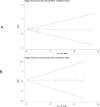Quantifying the evidence for the risk of metabolic syndrome and its components following androgen deprivation therapy for prostate cancer: a meta-analysis
- PMID: 25794005
- PMCID: PMC4368630
- DOI: 10.1371/journal.pone.0117344
Quantifying the evidence for the risk of metabolic syndrome and its components following androgen deprivation therapy for prostate cancer: a meta-analysis
Abstract
Background: No meta-analysis is yet available for the risk of metabolic syndrome (MetS) following androgen deprivation therapy (ADT) for men with prostate cancer. To summarize the evidence for the link between ADT and MetS or its components quantitatively with a meta-analysis including all studies published to date.
Methods: PubMed and Embase were searched using predefined inclusion criteria to perform meta-analyses on the association between metabolic syndrome, hyperglycemia, diabetes, hypertension, dyslipidemia or obesity and androgen deprivation therapy in patients with prostate cancer. Random effects methods were used to estimate pooled relative risks (RRs) and 95% confidence intervals (CI).
Results: A total of nine studies was included. There was a positive association between ADT and risk of MetS (RR: 1.75 (95% CI: 1.27-2.41)). Diabetes was the only MetS component present in more than 3 studies, and also showed an increased risk following ADT (RR: 1.36 (95% CI: 1.17-1.58)).
Conclusion: This is the first quantitative summary addressing the potential risk of MetS following ADT in men with PCa. The positive RRs indicate that there is a need to further elucidate how type and duration of ADT affect these increased risks of MetS and diabetes as the number of men with PCa treated with ADT is increasing.
Conflict of interest statement
Figures




Similar articles
-
Quantifying observational evidence for risk of fatal and nonfatal cardiovascular disease following androgen deprivation therapy for prostate cancer: a meta-analysis.Eur Urol. 2015 Sep;68(3):386-96. doi: 10.1016/j.eururo.2014.11.039. Epub 2014 Dec 5. Eur Urol. 2015. PMID: 25484142 Review.
-
Metabolic syndrome in men with prostate cancer undergoing long-term androgen-deprivation therapy.J Clin Oncol. 2006 Aug 20;24(24):3979-83. doi: 10.1200/JCO.2006.05.9741. J Clin Oncol. 2006. PMID: 16921050
-
Androgen deprivation therapy in prostate cancer and metabolic risk for atherosclerosis.J Clin Endocrinol Metab. 2008 Jun;93(6):2042-9. doi: 10.1210/jc.2007-2595. Epub 2008 Mar 18. J Clin Endocrinol Metab. 2008. PMID: 18349064 Review.
-
Increased risk of metabolic syndrome, diabetes mellitus, and cardiovascular disease in men receiving androgen deprivation therapy for prostate cancer.Pharmacotherapy. 2008 Dec;28(12):1511-22. doi: 10.1592/phco.28.12.1511. Pharmacotherapy. 2008. PMID: 19025432 Review.
-
Association of Androgen Deprivation Therapy with Metabolic Disease in Prostate Cancer Patients: An Updated Meta-Analysis.Clin Genitourin Cancer. 2023 Jun;21(3):e182-e189. doi: 10.1016/j.clgc.2022.12.006. Epub 2022 Dec 26. Clin Genitourin Cancer. 2023. PMID: 36621463
Cited by
-
Androgen-deprivation therapy and cognitive decline in the NEON-PC prospective study during the COVID-19 pandemic.ESMO Open. 2022 Apr;7(2):100448. doi: 10.1016/j.esmoop.2022.100448. Epub 2022 Mar 7. ESMO Open. 2022. PMID: 35344749 Free PMC article.
-
[Androgen deprivation therapy and cardiovascular morbidity in prostate cancer: a narrative review].Urologie. 2024 Mar;63(3):262-268. doi: 10.1007/s00120-023-02222-1. Epub 2023 Oct 24. Urologie. 2024. PMID: 37874334 Review. German.
-
Metabolic syndrome in patients with prostate cancer undergoing intermittent androgen-deprivation therapy.Can Urol Assoc J. 2016 Sep-Oct;10(9-10):E300-E305. doi: 10.5489/cuaj.3655. Epub 2016 Sep 13. Can Urol Assoc J. 2016. PMID: 27695584 Free PMC article.
-
Gonadotropin-releasing hormone agonists, anti-androgens and the risk of cardio-cerebrovascular disease in prostate cancer patients: an asian population-based observational study.J Cancer. 2020 Apr 6;11(14):4015-4022. doi: 10.7150/jca.38237. eCollection 2020. J Cancer. 2020. PMID: 32368283 Free PMC article.
-
Androgen deprivation therapy and cardiovascular disease: what is the linking mechanism?Ther Adv Urol. 2016 Apr;8(2):118-29. doi: 10.1177/1756287215617872. Epub 2015 Nov 30. Ther Adv Urol. 2016. PMID: 27034724 Free PMC article. Review.
References
-
- Huggins C, Stevens R, Hodge C (1941) Studies on prostate cancer: II. The effects of castration on advanced carcinoma of the prostate gland. Arch Surg 43: 209–223.
-
- Strum SB, McDermed JE, Scholz MC, Johnson H, Tisman G (1997) Anaemia associated with androgen deprivation in patients with prostate cancer receiving combined hormone blockade. Br J Urol 79: 933–941. - PubMed
-
- Sprenkle PC, Fisch H (2007) Pathologic effects of testosterone deprivation. Curr Opin Urol 17: 424–430. - PubMed
-
- Petrylak PJ, WM. (2002) Androgen Abliation for Prostate Cancer: Mechanisms and Modalities In: Kantoff PC, D'Amico PR., AV., editor. Prostate Cancer: Principles and Practice. Philadelphia: Lippincott Williams & Wilkins.
Publication types
MeSH terms
Substances
LinkOut - more resources
Full Text Sources
Other Literature Sources
Medical

